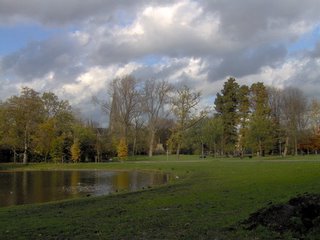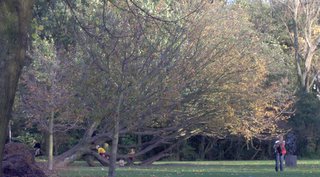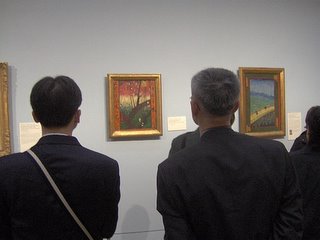Ein Traum des Freitagnachmittages im Vondelpark
 In 1957 my family was stationed in Germany and we visited Amsterdam. I have vivd memories of the canal tour in the glass-roofed boats, of white lace curtains in the hotel, and of visiting fields of tulips where windmills sails turned in the sun. That I can remember these thing so well is noteworthy because I have trouble remembering last year. So naturally I had to visit to see if my memory was accurate. I was surprised that it was and how much more came back to me.
In 1957 my family was stationed in Germany and we visited Amsterdam. I have vivd memories of the canal tour in the glass-roofed boats, of white lace curtains in the hotel, and of visiting fields of tulips where windmills sails turned in the sun. That I can remember these thing so well is noteworthy because I have trouble remembering last year. So naturally I had to visit to see if my memory was accurate. I was surprised that it was and how much more came back to me. 
 Amsterdam’s Canal Bus is my favorite, effortless, way to get to know the city—at least the part you want to know. I bought a 24-hour ticket on and just rode with no direction known along Amsterdam’s concentric canal rings. Whether you ride the red, blue, or green lines you eventually see it all.
Amsterdam’s Canal Bus is my favorite, effortless, way to get to know the city—at least the part you want to know. I bought a 24-hour ticket on and just rode with no direction known along Amsterdam’s concentric canal rings. Whether you ride the red, blue, or green lines you eventually see it all. 
Amsterdam’s canal rings were built in its 17th century glory days when Holland ruled the seas pushing Portugal out of Northeast Brazil and sharking the Indians out of Manhattan for a few bucks worth of glass beads.
 Those were the good ol’ days when Amsterdam’s population was growing like crazy every aspiring proto-capitalist entrepreneur wanted a house with access to the docks. So in what the Dutch claim as the first example of urban planning, the city was expanded along three concentric canals. Today a massive system of pumps maintains an artificial current that carries the dirty canal water to the North Sea.
Those were the good ol’ days when Amsterdam’s population was growing like crazy every aspiring proto-capitalist entrepreneur wanted a house with access to the docks. So in what the Dutch claim as the first example of urban planning, the city was expanded along three concentric canals. Today a massive system of pumps maintains an artificial current that carries the dirty canal water to the North Sea. 
Every house in old Amsterdam (without exception) has a hosting beam fitted with block and tackle because all (without exception) have steeeeeeeeeeeeep narrow stairs. Most houses are only about 30 feet wide—that’s why you need a block-and-tackle to get anything larger than a trunk upstairs. SO be advised when you book a “reasonable” hotel in old town, you will be climbing at least two if not more sets of stairs like THESE!!!  That’s why your hotel is “reasonable.”
That’s why your hotel is “reasonable.”
My reasonable hotel was the Abba. Clean, well-run, friendly and located on the # 1 trolley line near Vondelpark. 
I brought my guitar hoping to find music happening. But street music doesn’t happen in Amsterdam. I saw only three street musicians--a really fine clarinet and accordion duo, Turks whose music rolled together Middle Eastern and Mediterranean styles,  and an old bluesman who looked and sounded like he was from the delta.
and an old bluesman who looked and sounded like he was from the delta.  I did see a couple of calliope contraptions, however, powered by 2-cycle engines so noisy I could scarcely hear the bad circus music being pumped out. It seems odd, yet it is completely in character for A-dam.
I did see a couple of calliope contraptions, however, powered by 2-cycle engines so noisy I could scarcely hear the bad circus music being pumped out. It seems odd, yet it is completely in character for A-dam.
In his Internet Guide to Amsterdam [http://homepages.cwi.nl/], Steven Pemberton describes the city as “relatively quiet, and largely thanks to the canals, has relatively little traffic.” I beg to differ. A-dam it is, without a doubt, the noisiest city I’ve ever been in. In addition to the Dutch propensity to honk car horns a the slightest hesitation in traffic, there is the din of motor scooters, jet after jet after jet making thunderous landing approaches low over the city and the early morning wakeup call of street sweeping vehicles.  New York—of Dutch origin—doesn’t approach A-dam’s noise level. And while there is not lot a lot of automobile traffic, A-dam requires that you be alert on the street or die—horribly. The most likely risk of street death, if my experience is typical, is being speared by a bicyclist doing 50 kmph through red light, although close encounters with trolley cars no doubt also figure prominently in official Dutch death certificates.
New York—of Dutch origin—doesn’t approach A-dam’s noise level. And while there is not lot a lot of automobile traffic, A-dam requires that you be alert on the street or die—horribly. The most likely risk of street death, if my experience is typical, is being speared by a bicyclist doing 50 kmph through red light, although close encounters with trolley cars no doubt also figure prominently in official Dutch death certificates.
 Another A-dam oddity is its lack of anything like a local cuisine. Tourists hear about A-dam’s international restaurants because no national dishes exist—unless one counts various sorts of smoked fish offered by occasional vendors. Sort of a Hanseatic salted sushi.
Another A-dam oddity is its lack of anything like a local cuisine. Tourists hear about A-dam’s international restaurants because no national dishes exist—unless one counts various sorts of smoked fish offered by occasional vendors. Sort of a Hanseatic salted sushi.
Despite it all I love Amsterdam's friendliness. Only a few minutes after arriving, trying to get my bearings as I walked from the train station, a young man asked it I need help. Before I could say yes, he had me in tow, identified the streetcar line (#1) and helped me buy a ticket. “When I visited America everyone was helpful to me.” Where? “Miami South Beach. It was great,” he smiled “very warm.” Amsterdam was the home of Andre Gunder Frank, a good friend I never knew, whose obituary I was asked to write this year. 
I crashed early Thursday to be ready for Friday. I began by using up the remainder of my canal taxi ticket. More information recalled from the tape. The canal system allowed proto-capitalists to off-load their cargos from canal barges directly to their home/warehouse. That’s why they’re protocapitalists. 
And canal district buildings really do lean toward the water (it's not an after effect of an hour in the coffeebar sipping an expresso). It improves the mechanical efficiency of the beam-mounted block-and-tackle found on all old town houses. The the interior of the building might be mostly residence or mostly warehouse depending on the trade. One of the houses on the Red route was filled with huge built-in vats to store whale oil.  The family lived on the top floors.
The family lived on the top floors.
Then whaling shifted to the New England Yankees, and the house went down hill with the neighborhood. But now the old city canal buildings are being gentrified. Even the whale oil merchant's house has been converted to pricey apartments for those who work in the nearby financial district. 
By afternoon, I had taken all the canal tour I could handle—the impressive Elvis imitation of the ship pilot notwithstanding. So I disembarked and headed for my room and then for Vondelpark. 


Vondelpark, known as Amsterdam's lung, was created in 1865 by the Association for the Riding and Walking-Park. While the members genuinely wanted recreational space for thousands of working poor the creation of Vondelpark hiked local real estate values and led the wealthy to build elegant homes for themselves around the lung.


Vondelpark is a classic example of the 18th century serpentine style English landscape garden. The style is a carefully constructed artifice of “natural” vistas that open up as the visitor wanders along curving paths that wind around lakes and ponds set with temples, statues, and impressive trees.

 energy of his brush work.
energy of his brush work. 









0 Comments:
Post a Comment
<< Home